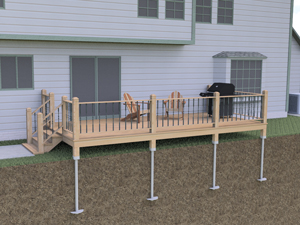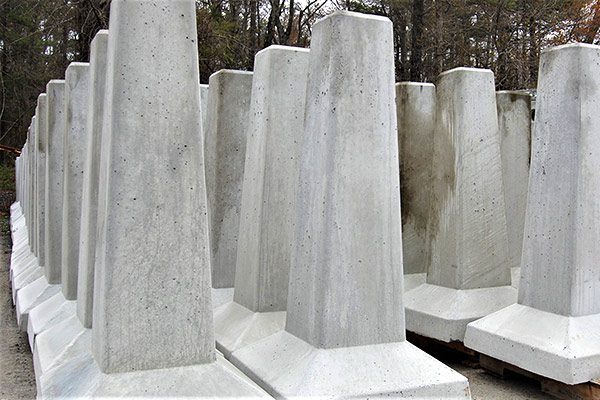Expert Tips for Installing Deck Footings to Assistance Your Outdoor Room
When it comes to building a deck, one of the most essential aspects to consider is the setup of correct grounds. These grounds are the foundation upon which your exterior space will certainly relax, offering stability and support for years to come. What exactly does it take to install deck grounds correctly?
Relevance of Proper Deck Grounds
Correct deck grounds are necessary for making certain the stability and durability of your outside space. Without solid and correctly installed grounds, your deck might come to be unsteady, leading to safety and security threats and pricey repair work.

Along with security, correct deck footings additionally contribute to the durability of your outside room (Deck Footings). Footings that are developed and built to stand up to the components and soil problems in your area will certainly assist stop the deck from settling or changing gradually. By guaranteeing the grounds are properly sized and mounted, you can decrease the risk of damages to the deck framework, extending its life expectancy and minimizing the demand for expensive repair work or substitutes

Choosing the Right Kind of Grounds
When selecting the proper kind of footings for your deck, it is essential to consider factors such as soil problems, neighborhood building regulations, and the overall layout of your outside room. The sort of footing you choose will certainly play an important function in ensuring the stability and durability of your deck.
One common type of ground is the concrete footing. Concrete footings are suitable for a lot of dirt conditions and give exceptional assistance for decks.
In many cases, you might need to use customized footings, such as stack footings or deep structures, if you are developing a multi-level or huge deck. These grounds are made to disperse the weight of the deck over a larger location, making sure stability and stopping settling or sinking.
Prior to picking a type of footing, it is necessary to seek advice from neighborhood building regulations and guidelines to ensure compliance. In addition, consider the style and meant use your outside area. Variables such as the dimension, form, and load-bearing needs of your deck will certainly affect the sort of footing that is most ideal.
Preparing the Ground for Footing Setup
To properly prepare the ground for footing installment, it is very important to analyze the soil problems and take necessary actions to make certain stability and sturdiness of the deck. The very first step is to dig deep into the area where the grounds will certainly be mounted. The depth of the excavation will depend upon the frost line in your area and the details demands of the deck style. It is crucial to eliminate any plant life, rocks, or particles from the excavation to make certain a strong structure.
When the area has been dug deep into, the next step is to compact the dirt. This can be done utilizing a plate compactor or by utilizing a hand meddle. Compacting the dirt assists to get rid of any spaces or air pockets, which can lead to settling and instability gradually.
After condensing the soil, it is essential to lay a layer of gravel or smashed rock at the bottom of the excavation. This will certainly supply water drainage and assistance to prevent water from merging around the footings, which can bring about disintegration and instability.
Step-by-Step Guide to Putting Up Deck Footings
After correctly preparing the ground for footing installment, the following step is to begin the process of setting up deck footings. This detailed guide will give you with a clear understanding of how to set up deck footings for your outdoor area.
Identify the location: Begin by noting the settings of the deck grounds making use of risks and string. Make sure that the areas line up with the layout and layout of your deck.
Dig the openings: Use a message image source opening miner or an auger to dig the openings for the grounds. The deepness and diameter of the holes need to be in conformity with regional building regulations and the particular requirements of your deck style.
Degree the holes: Use a level to guarantee that the holes are dug to the proper deepness and are degree with each various other. (Deck Footings)
Add crushed rock: Location a layer of crushed rock at the base of each hole to improve drainage and avoid the wood from decomposing.
Place the footings: Position the grounds into the openings, ensuring they are degree and plumb. Utilize a level and a determining tape to make certain precision.
Safeguard the grounds: Pour concrete into the openings around the footings, filling them to the top. Utilize an article level to guarantee the footings continue to be level as the concrete sets.
Enable time for treating: Allow the concrete cure according to the manufacturer's guidelines before proceeding with the deck construction.
Typical Blunders to Stay Clear Of Throughout Footing Installation
One crucial element to think about during the setup of deck footings is preventing common blunders that can endanger the security and long life of your outdoor room. While deck footings may look like a basic and straightforward component of the construction procedure, neglecting specific factors can result in expensive repairs and prospective security risks down the line.

In addition, disregarding to set up appropriate drainage actions can trigger water to accumulate around the grounds, causing rot, degeneration, and the eventual weakening of the deck's foundation. Furthermore, using the incorrect kind of footing product or failing to sufficiently safeguard the grounds can compromise their structural stability.
To stay clear of these blunders, it is necessary to seek advice from with an expert or adhere to sector standards to ensure correct ground installment. By doing so, you can make sure the security and durability of your outside room, giving a delightful and secure setting for several years to find.
Conclusion
To conclude, installing proper deck footings is crucial for the security and long life of your outside area. By selecting the best type of grounds and adequately preparing the ground, you can make sure a strong structure for your deck. Complying with a step-by-step guide and preventing common errors during footing setup will further enhance the durability and security of your deck.
Correct deck grounds are necessary for guaranteeing the stability and long life of your outdoor space. The grounds serve as a link in between the deck and the ground, permitting the weight of the deck and its occupants to be spread evenly into the soil.One typical type of footing is the concrete ground. Put the grounds: Position the grounds right into the holes, making sure go to these guys they are level and plumb. Safeguard the footings: Put concrete into the openings around the footings, filling them to the top.